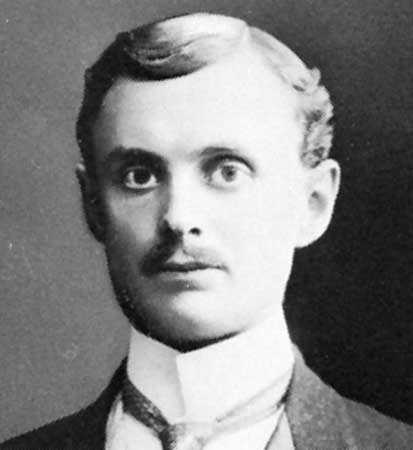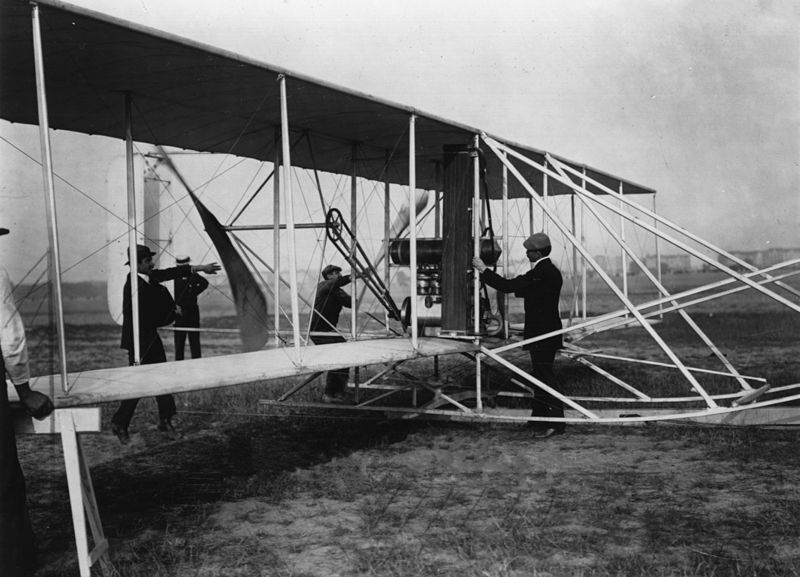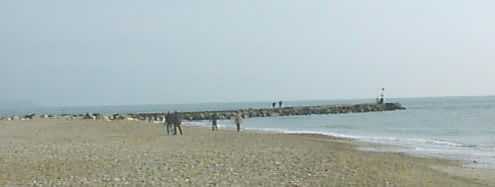Hengistbury Head in the 20th Century
A Tragedy at Hengistbury Head
At the start of the 20th century man finally conquered the air with heavier than air craft. The Wright brothers, in Dayton Ohio USA made the first successful powered flight on December 17th 1903. Their design was so good that it became the benchmark for early powered flight right up to the beginning of the First World War. Many pioneers began their flying careers with a Wright Flyer, including Charles Rolls, the founder and co-partner in the fledging Rolls-Royce company. Charles Rolls has purchased his Wright Flyer in 1910 and quickly became accustomed to the new craft. Meanwhile Hengistbury Head, or rather the open flat fields immediately to the West (including Barn Field and the area now occupied by St. Peters School and other buildings) became one of the worlds first air fields. An Air pagent was held at Hengistbury Head in July 1910 with almost all of aviators in the country attending. Many sightseers attended. For most of these sightseers this was the first time they had ever set eyes on one of the new fangled flying machines.

Charles Rolls. The joint founder of Rolls-Royce.Died at Hengistbury Head 12th July 1910
Charles Rolls took off in his Wright Flyer and gave a demonstration of the capabilities of the Wright brothers machine, but as he came into land something went terribly wrong. Some commentries speak of Rolls stalling the machine , others indicate there was a mechanical failure with part of the tail falling off. Either way, the machine fell to the ground from about 100 feet. Charles Rolls was mortally wounded with "Severe Concussion" and died in the wreckage, before medical assistance arrived.
Charles Rolls was the first person in Britain to die in an aircraft accident and the 12th in the world. He was 33 years old. A memorial to Rolls was erected and is maintained by the Royal Aeronautical Society in what is now the rear playing field at St Peters School. After his death, the firm of Rolls-Royce went onto ever greater things, but without his early entrepreneurial guidance and flair it is doubtful whether the firm would have been such a success.
Steve Robson has kindly contributed two pdfs containing information regarding the flying accident and death of Charles Rolls (of Rolls Royce) at Hengistbury Head in 1910.
The Charles Rolls Memorial Trust - PDF-here
The Charles Rolls Memorial Trust 2010 Air pagent and St Peters School Memorial. PDF-here
Hengistbury Airfield never really picked up. It was finally abandoned in the 1920's due to the popularity of the larger and more practical Christchurch Airfield which was just outside Christchurch, sandwiched between Stanpit and Somerford. Christchurch Airfield was closed in the 1960's. The main airport now is Hurn ( Now called Bournemouth International Airport) which came into existence in the 1930's.
(thanks to Kit Yardley for the information)

The Wright Flyer similar to the one flown by Charles Rolls at Hengistbury Head
Archeological Finds
At the same time as Hengistbury Head airfield was being developed (1909) the first significant archaeological finds were made on the North Eastern lowlands of the head. These finds, coupled with the potential sale of Hengistbury Head to developers by the then owner Sir George Meyrick led local antiquarian Herbert Druitt to try and save Hengistbury Head for posterity. He tried to raise interest from the National Trust but to no avail. He then approached the Society of Antiquities in the hope of performing a last excavation to try and save the archaeological history of Hengistbury Head from developers. Luckily the Society of Antiquities took heed of Herbert Druitts warnings and mounted an excavation under the direction of J.P. Bushe-Fox starting in 1911.
Shortly into this excavation it was realised that the nature of the finds being made were very significant and this weighed heavily against proposed developments. A scheme for 80 residential properties to be built west of the Double Dykes was dropped as was a scheme to construct a golf course on Warren Hill. However some preparation work was done for both of these schemes, mainly involving the ploughing of both areas. A great deal of antiquarian value must have been lost at this time, just as Mr Bushe-Fox was performing a detailed analysis that at times must have been only a few metres away from the ploughing.
Change of Owner
During World War One the Sir George Gray sold the head to Mr Gordon Selfridge. Due to the constraints imposed by the war development planned by Mr Selfridge was delayed. Selfridge planned to build a huge mansion on Warren Hill. As part of this scheme a nursery garden was planted in the lee of the head west of the open cast mine. This exists today, although it has deliberately been left to go wild and now forms a bird sanctuary. Bushe-Fox published a report in 1915 although other excavations took place through to 1924. Finally Selfridge abandoned the scheme for his residence on Hengistbury Head and in 1930 sold the head to Bournemouth Borough Council. From then on the Head has been designated a public open space and recreational area.
Building the Long Groyne
During the period since the closure of the open cast mine in the latter part of the 19th century there had been a catastrophic loss of headland due to erosion with almost half of Hengistbury Head having been washed away. All of the spoil from the head ended up being dumped by long shore drift at the far end of Mudeford sandspit.

The Long Groyne in 2001
It was prevented from piling up against the quay by the river exit known as The Run. Consequently a long tail built up off Mudeford Sandspit stretching at time for over a mile from the Black House down to opposite Steamer Lodge.
A Cyclic event set up where a storm would trigger the formation of a lagoon which would then slowly fill with sand. This happened a number of times over the years until in 1935, Bournemouth Council took positive action to save Hengistbury Head and built a breakwater out from the eastern tip towards the Beer Pan rocks, (these rocks probably mark the original extent of the Head before the mining activity). This breakwater is now known as the Long Groyne.
Recognition as a Special Place
At the same time and arguably more environmentally detrimental, the Council built an access road to Hengistbury Head called the Broadway. This brought many visitors to Hengistbury Head along with a new set of environmental pressures. Since then, to aid the visitors and also reduce the damage from trampling, a number of paths have been built. A visitors centre along with a cafe and a sail training centre was built in the 1960's and the low level path from the Double Dykes to the north end of Mudeford Sandspit was tarmacked. A Land or Noddy train service from the visitor centre to Mudeford Sandspit was instigated. Two large car parks were built. Controversially they were excavated and consequently there was a possible loss of archeological information at this time. Mudeford Sandspit, once a mass of huge sand dunes became populated with a myriad of beach huts of varying sizes and shape.Because of the beauty of the surrounding area these little huts changed hands for ever increasing sums and in the late 90's and early part of the 21st century were regularly achieving sale prices of over £100,000. During the latter part of the 20th century the special scientific and cultural value of Hengistbury Head was formally recognised and it was designated a Special Site of Scientific Interest (SSSI). It is also designated as Green Belt, which prevents anything but the most necessary and special building development from taking place.